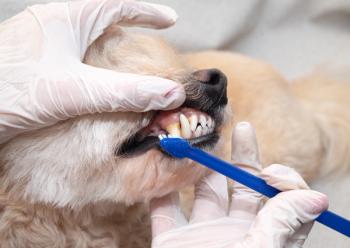
It’s time to act on tooth fractures
Sticks and stones may break your veterinary patients’ teeth, but these words (from you) can really hurt them: “Let’s keep an eye on it.”
Waiting around on fractured teeth isn’t all it’s cracked up to be. In fact, according to veterinary dentist Barden Greenfield, DVM, DAVDC, it’s downright negligent. “There are too many veterinarians who say, ‘Let’s keep an eye on it,’ and that’s tantamount to malpractice,” he explains.
Instead, Greenfield, owner of Your Pet Dentist in Memphis and Little Rock, recommends clear action steps. First, you’ll need to find out when the fracture occurred. If the fracture is fresh (within the last 48 hours), the tooth can potentially be saved with a vital pulpotomy and partial pulpectomy—no root canal required. If the fracture is more than 48 hours old, however, he says you have 2 options: root canal or extraction.
Referring a patient for root canal therapy isn’t a bad choice for strategic teeth like maxillary and mandibular canines, fourth upper premolar, and the first mandibular molars, says Greenfield, but only if it’s practical. If you live in a rural area and don’t have a veterinary dentist nearby who can perform the procedure (or a vital pulpotomy and partial pulpectomy, for that matter), extraction may be your only real option.
In addition to geography, pathology and pocketbooks can also narrow your choice, says Greenfield. “It may be that when you take x-rays, there’s too much disease apically, there’s a root fracture, or it could be economics,” he explains. “We all know that money doesn’t grow on trees, and endodontic therapy could be a little bit more expensive.”
So while you may need to sit down and talk through the options with your client, don’t sit on your hands. “Leaving it to percolate,” says Dr. Greenfield, “is not an option.”
Editor's note: This article is based on a dvm360.com video featuring Sarah Wooten, DVM, and Barden Greenfield, DVM, DAVDC. Watch it
Newsletter
From exam room tips to practice management insights, get trusted veterinary news delivered straight to your inbox—subscribe to dvm360.





